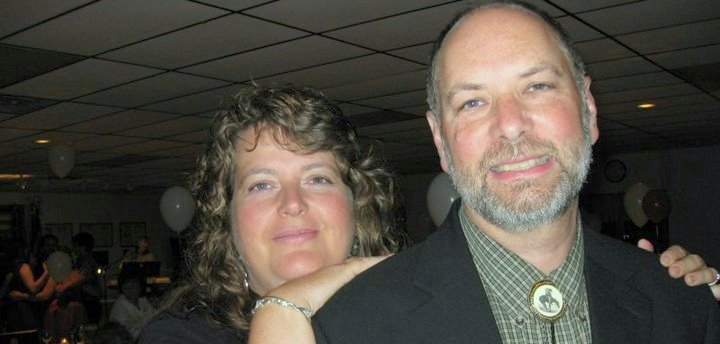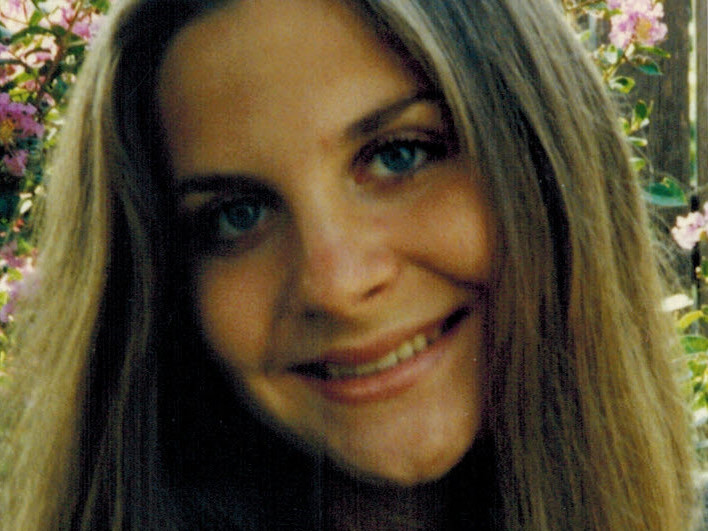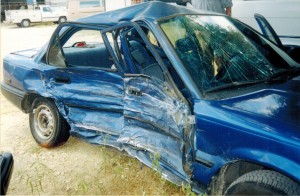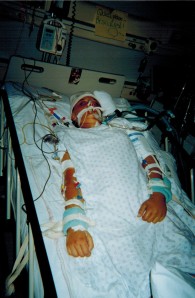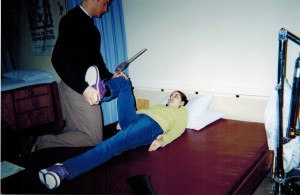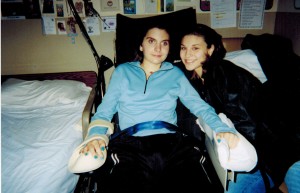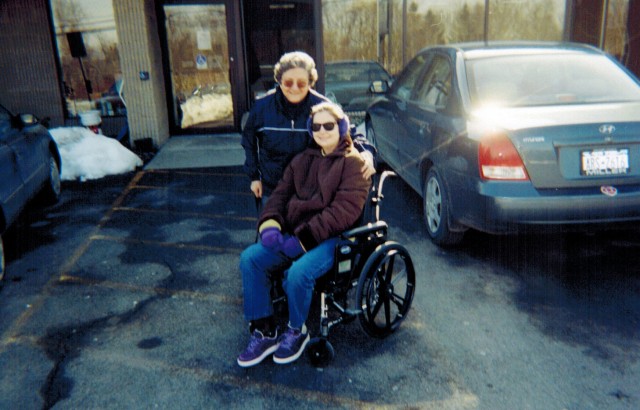The Girlfriend’s Guide to TBI
Or Everything Your Doctor Won’t Tell You
When I was first told I had a traumatic brain injury (TBI) I thought “Well, duh, just look at my head!” It was swollen and stapled together from a craniotomy – of course I knew I had a TBI! Along with the obvious, though, I also knew that I was given a rare opportunity. If you do the math, the chance of someone surviving 2 cerebral ruptures is only 1/10 of 1%, and I was one of those improbable survivors. It was like winning the “Second Chance at Life Lottery”, a prize that was both astounding and wonderful, yet carried with it a steep tax burden that wouldn’t be easy to pay.
February 1, 2005 was a miserable snowy day. Regardless, I reported to my first job that day and was driving to my second job when I passed out and apparently skidded off the road, free-falling over a 60 foot embankment. A brain aneurism in my right middle cerebral artery had burst, instantly filling my head with blood and knocking me out cold. I don’t know how, but I miraculously avoided flipping my Jeep Cherokee or hitting every tree in my path on the way down. Someone in a blue pick-up truck saw fresh car tracks in the snow, called 911, and then left once the police arrived. I will forever be indebted to you, Mystery Person in the Blue Truck, because without you, I may not be here today.
I was taken by ambulance to Albany Medical Center and when my husband, Nate, arrived at the hospital, the doctors told him to say his goodbyes – I probably wouldn’t make it through surgery. I survived the surgery, only to find that my ordeal was just beginning. After weeks of grueling therapy I looked at Nate and told him “my head feels funny”. He rushed me back to the hospital where they found a second “pseudo” aneurysm bleeding. A shunt was surgically placed, but at my six month check up, the aneurysm was growing. There was no choice but to operate, so, during yet another surgery – this one 23 hours long – a bypass artery was placed to allow proper blood flow .
My railroad head
Yes, I beat the odds again and survived that third surgery, too. But no one could prepare me for what was to follow. My physical balance was gone and my hands wouldn’t work. I had to relearn how to relate to people and what was appropriate to say. I have a tendency, like most brain injured people, to just say whatever I am thinking at the moment. As you can imagine, this was a poor way for me to make friends or keep the ones I already had. I also noticed that I had lost my ability to multi-task in any way – just talking on my cell phone while walking through a store was a disaster – me, crashing into people and products set up in the aisle. I could no longer make a quick decision or solve a problem. Even going to get ice cream usually resulted in just picking the first flavor I saw and dealing with it later because I was too overwhelmed to make an actual decision. “Are you sure you want bubble gum ice cream, honey?” Nate would ask, well aware of what I was doing but not knowing exactly how he could help me.
It didn’t take me long to figure out that maneuvering through my new world wasn’t going to be easy. Unfortunately, I also discovered that help was hard to find. I remember early on in recovery wondering if all the “weird” things I was experiencing were indeed “normal” after an aneurysm. Of course, all the doctors could offer me was a shrug of their shoulders and a “it is a function of the brain”. No. Not much help at all. One day, out of desperation, I found myself wandering through the isles in the library, searching for the almost non-existent book about how to recover from a brain injury when I came across a book entitled, The Girlfriends’ Guide to Pregnancy: Or Everything Your Doctor Won’t Tell You, written by Vicki Iovine. Okay, NO, I DID NOT read the book or even flip through it for that matter, I don’t want to know what it has to say, but the title caught my eye. I had an idea. Childbirth is another one of those things that never goes quite the way the glossy brochures in the doctor’s office say it will, so I thought , hmmm – it might make for an interesting blog post to take the same approach.
For those of you who don’t know me well, I realize there is nothing funny about how the brain deals with a TBI. Neither am I minimizing the fear and anxiety that follows. This is just my feeble attempt to cope with all I have been through and hopefully make you smile!
Okay, here it goes:
“The Girlfriend’s Guide to TBI: Or Everything Your Doctor Won’t Tell You”.
1. I choke on my own spit daily now (probably the lingering effects of a stroke). If this happens to you, blame it on your TBI.
2. I get hiccups after eating or drinking. I blame this on my stroke, too, so feel free to add your own twist.
3. I can no longer “hurry”. My brain just shuts down if I have to do anything quickly! Feel free to shut down on a regular basis.
4. I constantly unlock my house, go back inside, and then lock it again from the inside – only to find the keys are still hanging in the door. I do this every time – I still haven’t mastered the sequence five years later!
5. I didn’t have an appetite for years. I had to set a timer to remind me to eat or I would forget. Chocolate, of course, can always be your exception.
6. For about a year, simply taking a shower would require a nap to follow. It was so exhausting!
7. I used to walk through the grocery store saying the name of each item I saw. I had to do this or I wouldn’t recognize what I was looking for. For example, I would be looking for tea and walk right past it unless I was actually saying it out loud. I even once asked somebody if I was really seeing cake mix because the store had been re-organized and I was sure the aisle I just went down used to have juice in it. Can you imagine what that poor person was thinking? They probably went to look for a butterfly net……
8. When you take a nap, you will wake up convinced it is the next day. There will not be a person anywhere who can talk you out of this.
9. If doctors tells you that parts of your brain have died as a result of the bleed/stroke, they are probably right. Arguing with them will not change this fact. It is OK. Even “normal” people only use a small percentage of their fully living brain.
10. Feeling “numb” is normal. It feels like you are just watching the world go on but you are not actually a part of it. Perhaps it is sheer exhaustion and perhaps the brain can’t keep up with such a rapid world!
11. I would randomly vomit from time to time. Poor Nate (my hubby) has often been an involuntary human shield. I think I have had every organ and system checked for proper functioning. It always checks out okay, so doctors just shrug their shoulders and say “it is a function of the brain”. Yeah, yeah.
12. Okay, Ladies, let’s just get real for a moment. While swimming offers a buoyancy effect that is helpful for those with paralyzed extremities, the thought of putting on a swimsuit in March is not a favorite thing for any women of any age. I was a pale, bag of bones who hadn’t shaved since February 1st (possibly longer). Shaving was painful as you can imagine! To make matters worse, my whole central nervous system was frazzled and all sensory input felt like another assault. So, feel free not to shave (unfortunately, you can’t skip the swimsuit).
13. Dialing a phone number was a nightmare and often impossible to do. I could not transfer a number from one place to another. Also, I tried to balance the neglected checkbook once and it caused a massive meltdown!!!
14. Talking too much makes me nauseous.
15. When I sleep now, I just radiate heat for some reason?
16. At first, I had to have my husband, Nate, sit down with me to help plan the next day. We would write numbers next to the event in my planner so I could figure out how to execute the activities for that day. It is 5 years later and I still need his help sometimes (but now I can usually do it by myself… I think).
17. All time and events are measured by my aneurysm rupture. Everything is either “that was before my aneurysm” or “that was after my aneurysm”.
18. My short-term memory was terrible but it is slowly improving. I still have to write EVERYTHING down in my daily planner, though.
19. I was an emotional basket case. I cried at literally everything (even answering a phone), until I was put on a mood stabilizer.
20. I will say that the gift of Moonlight Path Body Wash and Lotion from my friend’s, The Masons, was just what I needed to feel just a little bit more human. Oh, to not smell like a hospital was, and still is, priceless!
21. My faith has carried me through, along with the love and support of an amazing husband, family and friends. A good friend once told me, “Lisa, no matter how many time you fail, you are not a failure! I don’t know about you, but sometimes I still need to hear that from time to time.
22. Finally, I want to share what I consider the thing that makes every pain-staking minute of recovery worthwhile. The “silver lining”, if you will, is ALL OF THE MOMENTS OF LIFE I didn’t miss out on – thanks to my exceptional good fortune of surviving the odds.
Thanks for listening. Love to all of you, Lisa
PS: If you get a chance, check out my blog at:
walkingtalkingmiracle.blogspot.com
Words of Wisdom from Lisa’s husband, Nate
“You just have to be patient and faithful, that’s the only advice I have.”
 Lisa’s story was condensed from Lisa’s blog, *Walking*Talking*Miracle
Lisa’s story was condensed from Lisa’s blog, *Walking*Talking*Miracle
Written by Lisa W.
Paula Schmidt, Editor
You can also read Lisa’s Story on Brainline: http://www.brainline.org/content/2012/03/the-girlfriends-guide-to-tbi-or-everything-your-doctor-wont-tell-you.html





